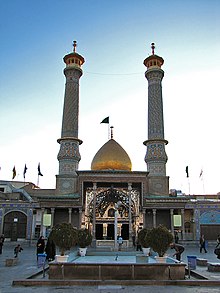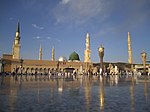Shah Abdol-Azim Shrine
| Shah Abdolazim (Abdol-Azim) Shrine شاه عبدالعظیم | |
|---|---|
 | |
| Religion | |
| Affiliation | Shia Islam |
| Province | Tehran Province |
| Location | |
| Location | Rey, Iran |
| Municipality | Ray County |
| Geographic coordinates | 35°35′08″N 51°26′07″E / 35.58556°N 51.43528°E |
| Architecture | |
| Type | Mosque |
| Completed | 9th century |
The Shāh Abdol-Azīm Shrine (Persian: شاه عبدالعظیم), also known as Shabdolazim,[1][2][3] located in Rey, Iran, contains the tomb of ‘Abdul ‘Adhīm ibn ‘Abdillāh al-Hasanī[4] (aka Shah Abdol Azim). Shah Abdol Azim was a fifth generation descendant of Hasan ibn ‘Alī[4] and a companion of Muhammad al-Taqī.[4] He was entombed here after his death in the 9th century.
Adjacent to the shrine, within the complex, include the mausolea of Imamzadeh Tahir (son of the fourth Shia Imam Sajjad) and Imamzadeh Hamzeh (brother of the eighth Twelver Imām - Imām Reza).
Background[edit]
Abdol Azim migrated to Rayy out of persecution[4] and subsequently died there. A piece of paper was found in his pocket outlining his ancestry as being: ‘Abdul ‘Adhīm son of ‘Abdillāh son of ‘Alī son of Hasan son of Zayd son of Hasan ibn ‘Alī.[4] Shah Abdol Azim was sent to Rayy ( Modern day Tehran) by Imam Reza.
History and design[edit]

Ibn Qūlawayh al-Qummī (d. 978 CE) "includes the shrine in his Kāmil al-Ziyārāt, one of the earliest pilgrimage guides for the Shiʿa, which suggests that the tomb of ʿAbd al-Aẓīm was already of some importance by the tenth century."[5][6] The tomb of Abdol-Azim had also come under the patronage of Sunni rulers at times, a notable example being the mausoleum constructed over Abdol-Azim's tomb in the 1090s CE by orders of the Seljuk vizier Majd al-Mulk Asʿad b. Muḥammad b. Mūsā.[7][8][9][10]

This door has an inscription in Tulth calligraphy.
Notable Burials[edit]
- Abdol-Azim al-Hassani (789–866) – medieval scholar
- Morteza Razi (fa) (11th cent.) – medieval scholar
- Abu al-Futuh al-Razi (1087–1157) – medieval scholar
- Ahmad Monshi Qomi (1547–1607) – scholar
- Abolghasem Ghaem-Magham Farahani (1779–1835) – prime minister (1834–35)
- Mohammad-Sharif Khan Mafi (fa) (d. 1847) – politician
- Qaani Shirazi (1808–1854) – poet
- Saadat-Ali Shah (fa) (d. 1876) – leader of Nematullahi Gonabadi Sufi order
- Abbas-Ali Dadashbeig (fa) (1814–1878) – military officer and father of Reza Shah
- Mohammad Khan Majd ol-Molk Sinaki (fa) (1809–1881) – politician
- Bahram Mirza Moezz od-Dowleh (1806–1882) – Qajar prince and politician
- Ali Kani (1805–1888) – cleric
- Nasser al-Din Shah Qajar (1831–1896) – Shahanshah of Persia (1848–96)
- Mohammad-Ali Sadr ol-Mamalek (fa) (d. 1902) – politician
- Vajihollah Mirza (az) (1854–1905) – Qajar prince and politician
- Sattar Khan (1866–1914) – a leader of Persian Constitutional Revolution
- Soltan Hossein Mirza Jalal od-Dowleh (fa) (1868–1914) – Qajar prince and politician
- Nour-Ali Shah II (fa) (1867–1918) – leader of Nematullahi Gonabadi Sufi order
- Abolhassan Mirza (az) (1847–1919) – Qajar prince and politician
- Mohammad Tabatabai (1842–1920) – cleric a leader of Persian Constitutional Revolution
- Malek-Mansour Mirza Sho'a' os-Saltaneh (1880–1920) – Qajar prince
- Mohammad Khiabani (1880–1920) – politician
- Abolqassem Naser ol-Molk (1866–1927) – politician and regent of Persia (1911–14)
- Ahmad Bader Nasir od-Dowleh (fa) (1870–1930) – politician
- Raf'at Semnani (fa) (1882–1931) – poet
- Mohammad-Hossein Nadoushani (fa) (1864–1932) – politician
- Ali-Mardan Khan (fa) (1892–1934) – chief of Bakhtiari tribe
- Banoo Ozma Eftekhar od-Dowleh (fa) (1857–1935) – Qajar princess
- Nezameddin Hekmat Moshar od-Dowleh (fa) (1883–1936) – politician
- Abdollah Haeri Rahmat-Ali Shah (fa) (1862–1937) – Sufi leader
- Mohammad Aghazadeh Khorasani (1877–1937) – cleric
- Firouz Mirza Nostrat od-Dowleh (1889–1938) – Qajar prince and politician
- Abdol-Hossein Mirza Farmanfarma (1852–1939) – Qajar prince and politician
- Reza Shah Pahlavi (1878–1944) – chief of Persian Cossack Brigade (1920–21), prime minister (1923–24) and Shahanshah of Iran (1925–41) (Reza Shah's mausoleum)
- Gholamhossein Rahnama (fa) (1882–1946) – scholar
- Sadr-ol-Eslam Khoei (fa) (1887–1948) – scholar
- Mohammad Qazvini (1877–1949) – scholar
- Esmail Merat (1893–1949) – politician
- Abdollah Mostowfi (fa) (1878–1950) – politician
- Mostafa Adl (1882–1950) – politician
- Haj-Ali Razmara (1901–1951) – prime minister (1950–51)
- Moahammad Mazaher (fa) (1875–1954) – politician
- Ali-Reza Pahlavi (1922–1954) – Pahlavi prince and son of Reza Shah
- Abbas Eqbal Ashtiani (1896–1956) – scholar
- Ali Soheili (1896–1958) – prime minister (1942, 1943–44)
- Mohammad-Sadegh Tabatabaei (1881–1961) – politician
- Abolghasem Kashani (1882–1962) – cleric and politician
- Fazlollah Zahedi (1892–1963) – army general and prime minister (1953–55)
- Tayyeb Haj-Rezaei (fa) (1911–1963) – political activist
- Abdol-Azim Gharib (ru) (1879–1965) – scholar
- Nezam-Vafa Arani (fa) (1887–1965) – poet
- Hassan-Ali Mansur (1923–1965) – prime minister (1964–65)
- Ziaeddin Tabatabaei (1889–1969) – journalist and prime minister (1921)
- Badiozzaman Forouzanfar (1897–1970) – scholar
- Ahmad Matin-Daftari (1897–1971) – prime minister (1939–40)
- Mohammad-Ali Emam-Shoushtari (1902–1972) – scholar
- Davoud Maghami (fa) (1938–1972) – politician
- Mohammad-Kazem Assar (fa) (1884–1975) – scholar
- Ahmad Ashtiani (1882–1975) – cleric
- Hajj Khazen Ol-Molk (1831-1901) – merchant, scholar
- Mohammad-Amir Khatami (1920–1975) – commander in chief of IIAF (1958–75)
- Ali-Asghar Hekmat (1892–1980) – politician
- Soleiman Behboudi (fa) (1896–1981) – politician
- Nasrollah Falsafi (fa) (1901–1981) – scholar
- Reza Mafi (fa) (1943–1982) – calligrapher
- Hassan Nayyerzadeh (fa) (1928–1983) – scholar
- Karim Amiri Firuzkouhi (1910–1984) – painter
- Mohammad-Ali Hedayati (fa) (1910–1986) – politician
- Amanollah Ardalan Ezz-ol-Mamalek (fa) (1884–1987) – politician
- Mehdi Soheili (fa) (1924–1987) – poet
- Hossein Lankarani (fa) (1889–1989) – politician
- Shamseddin Jazayeri (fa) (1913–1990) – politician
- Mohammad Taghi-Falsafi (1908–1998) – cleric
- Abdol-Karim Haghshenas (1919–2007) – cleric
- Abolghasem Gorji (fa) (1923–2010) – scholar
- Mohammad-Ali Taraghijah (1943–2010) – painter
- Mostafa Ahmadi Roshan (1979–2012) – scholar
- Azizollah Khoshvaght (1926–2013) – cleric
- Mojtaba Tehrani (1937–2013) – cleric
- Sadegh Tirafkan (1965–2013) – artist
- Vali Akbar (fa) (1970–2013) – wrestler
- Mohammad-Reza Mahdavi Kani (1931–2014) – cleric and prime minister (1981)
- Parviz Moayyed-Ahd (fa) (1929–2016) – scholar
- Mohammad-Taghi Nourbakhsh (fa) (1962–2018) – scholar
- Mohammad-Ali Shahidi (1949–2020) – cleric and politician
- Ali Akbar Mohtashamipur (1947–2021) – cleric and politician
- Seyyed Mohammad Ziaabadi (1928-2021) - cleric
See also[edit]
References[edit]
- ^ Abdol Azim Hasani iribnews.ir
- ^ Shrine of Shah Abdol-Azim aparat.com
- ^ Shah Abd al-Azim mashreghnews.ir
- ^ a b c d e al-Qummi, Ja'far ibn Qūlawayh (2008). "107". Kāmil al-Ziyārāt. trans. Sayyid Mohsen al-Husaini al-Mīlāni. Shiabooks.ca Press. p. 658.
- ^ Ibn Qūlawayh al-Qummī, Kāmil al-Ziyārāt (Beirut, 1418/1997), pp. 536-537
- ^ https://eprints.soas.ac.uk/17407/1/SI_108_01_1-15.pdf [bare URL PDF]
- ^ ʿAbd al-Jalīl b. Abū al-Ḥasan al-Qazwīnī (fl. 1189), Kitāb al-Naqḍ (Tehran, 1371/1952), p. 220
- ^ W. Barthold, An Historical Geography of Iran (Princeton, 1984), p. 127
- ^ Sheila Blair, The Monumental Inscriptions from Early Islamic Iran and Tran-soxania (Leiden, 1992), p. 185
- ^ Leisten, Architektur für Tote, pp. 240-241.
Further reading[edit]
- Kondo, Nobuaki (2018). "State and Shrine in Iran: Waqf Administration of the Shah ͑ Abd al-͑ Azim Shrine under the Qajars". In Miura, Toru (ed.). Comparative Study of the Waqf from the East: Dynamism of Norm and Practice in Religious and Familial Donations. Tokyo. pp. 1–25.
{{cite book}}: CS1 maint: location missing publisher (link) - Kondo, Nobuaki The Shah ʿAbd al-ʿAzim Shrine and its Vaqf under the Safavids.[1]



